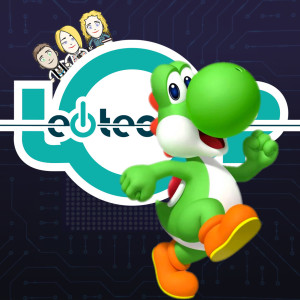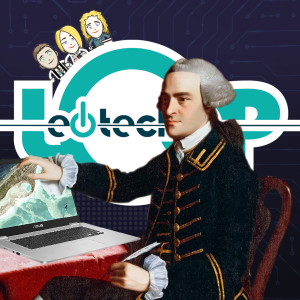Episode 13 of the TechNollerGist Podcast featuring Traverse City Area Public Schools EdTech Coach, David Noller, sharing some great tips on managing digital device usage in your classroom.
Show Transcripts:
David Noller 0:06 Legos on it you step on them and say things. Then I respond. That's how this works.
Larry Burden 0:10 Scream in pain.
David Noller 0:11 I can't tell you how excited I am.
Larry Burden 0:17 It's Episode 14 of the TechNollerGist podcast I'm Larry Burden and he always feels like somebody is watching him, or at least should be. It's the TechNollerGist, David Noller.
David Noller 0:27 For full entertainment value, should be.
Larry Burden 0:29 Should be, and maybe for the safety of others but that's,
David Noller 0:32 Not participating, just observing.
Larry Burden 0:35 Exactly.
David Noller 0:35 Fair enough.
Larry Burden 0:36 Today's topic should you choose to accept it, Keeping the lids down or managing in-class device usage. So you just showed me your, your show notes. And I had mentioned, I'm just going to ceed the floor because we've talked about several of the items that you had sent me previously in other pods, and anybody that has digital devices in their classroom, which is pretty much everybody. I mean, K-12, at this point,
David Noller 1:03 Right,
Larry Burden 1:04 How to manage that device and make it a successful learning tool, I think is...any advice is good advice. So,
David Noller 1:11 Yeah, I'm going to start with something I see at the high school every day. When I walk in and I parked in my spot. There will often be a parent, waiting for their student, parked in the handicapped space. That driver does not have a tag or a license plate. It's just a convenient place to pick up their child from school. They know they're not supposed to park there, but they do it anyway because it's convenient. Every day we see people drive through those stop signs. Like the Michigan rolling stop, and sometimes just there's nobody in the crosswalk we're just going to go.
Larry Burden 1:42 I've been in your high school. Oftentimes is not a rolling stop there's no consideration of stopping whatsoever.
David Noller 1:47 I'm being generous. So, you know, they know they're not supposed to, but it's not convenient for them to stop for some reason so they just keep on going through, often with their students in the car with them and what they're doing is demonstrating that rules are for sometimes, and when you're confronted with legal and ethical dilemmas you can kind of determine your response based on whether or not anybody's watching.
Larry Burden 1:49 You're not breaking the law unless you get caught.
David Noller 2:16 Well there you go. It's not illegal unless you're caught. You're still breaking the law.
Larry Burden 2:20 yeah, valid
David Noller 2:20 So the reason I bring that up is because of what I want to bring up with the, the first item, which is; within the ISTE standards, there are standards for students, and there are standards for teachers. And for the student it says that, students engage in positive, safe, legal and ethical behavior when using technology, including social interactions online, or when using networked devices. We give them network devices, the ISTE standard is that they will engage in use those tools in a legal, ethical way. But there's also a teacher strand, to the ISTE standards, and under Citizen, 3.C., mentor students and safe, legal, and ethical practices with digital tools, and the protection of intellectual rights and property. And 3.D., model and promote the management of personal data, and digital identity and protect student data privacy.
Larry Burden 3:14 I see where we're going here.
David Noller 3:15 Yeah, so, like the parents or others who drive through a stop sign or wait to pick up the child in the handicap space, we as teachers need to model legal and ethical behavior for our students if we're going to ask them to do the same. And that has a lot to do with device management as it turns out.
Larry Burden 3:37 Okay,
David Noller 3:37 Because modeling legal and ethical behavior doesn't just mean citing your sources. Using pictures in your presentation and citing them and making sure that you're using them in a legal and ethical way. It also has to do with how that students participating in the social world of the classroom, and that we've responded to some of the challenges we've had with mobile devices by just banning them. Kids can't have phones in the room because they don't know how to use them properly and so we're just going to say, you can't have them. But everybody's got a laptop. And you still have to manage their participation in that community in a way that they can demonstrate legal and ethical behavior. And for that to happen I think teachers need to structure their lessons so that the student is in the habit of using that device in the educational model, and that's it. And not using it to distract themselves, etc. I think that gets into maybe not the legal aspect, but the ethical aspect of using the tool.
Larry Burden 4:36 I like to compare it to a hammer. It's a great tool for what it's used for. But you don't go, you know what, there's no nail around here right now, so feel free to do whatever you want with that hammer.
David Noller 4:48 I love that. Yeah, there's no nail so use it for whatever you want to. And honestly, I think that's a great metaphor for what happens in classrooms. We start students on a task, maybe there's not a, an end game, or a time limit and kids finish and then all of a sudden they're like, well?
Larry Burden 5:07 I've got this hammer.
David Noller 5:08 I've got this hammer to use, let me, let me pound a hole in the wall. And I think, in part, this might be based on some of our old practices. The old devices we used to have in the classroom took like 30 seconds to a minute to boot up, and make some of the teachers of my generation are used to seeing open laptops, because to shut them down, and then to open it back up again. You lost a couple minutes of instructional time.
Larry Burden 5:31 I remember having conversations, not long ago where we would discuss, okay we have to understand that there's going to be a boot up time right and be patient with that.
David Noller 5:41 Right. These Chrome devices, boot up instantly. So, I've even changed my practice where we had a warm up question where they responded on, on Google Classroom. Then they close their lids. I gave them a little bit of information that they needed in order to do the next task, open your lids. Do that task. They had seven minutes to do that task, close your lids. We did, we played a game today, we did a simulation of village building, world building, in my sociology class. Lids were down for that, and then last three minutes, open up your laptop and respond to that review question after the experience. So it was up, down, up, down, up, down, all throughout the day, and not once did a kid have enough time to do my task and get distracted away from the learning of the day. I had a kid fall asleep, that had nothing to do with the device, didn't go to bed till four in the morning. So it's not perfect, but it wasn't the devices fault that somebody got off task. And it wasn't my lack of managing their experience with the devices fault.
Larry Burden 6:50 I completely see where that paradigm is changed from the past where a teacher would have a laptop time, open them up, recognize it's going to take a minute and a half to get the laptop up, and we're going to do whatever we can while that while that lid is up, and then when we close that lid, it's done.
David Noller 7:10 I used to actually scheduled warm ups, during open the lid time. So we get the computers, bring it back to our tables, open them up, set the power, and then do like, our opening question while it powered up. And in that, you know kids are constantly going back and forth checking to see if it's up okay now it's time for my password. So that kind of stepping through a lesson, I guess I'm jumping back to the example, that kind of stepping through the lesson when it's intentional, and you're like, this is a question that's going to take three minutes and then close your lids. Then you do your instruction, whatever you're going to do for the day. If they are ready to respond, then they open it back up again. I think that's something that we're not seeing a lot of in the classroom. That we're not seeing teachers manage the availability. And I, that as an opening step, it's actually very easy to do. It's something everybody can do. And I think it's going to resolve a large percentage of problems that people might be having already in the classroom. I have some other ideas for other things, but that's probably the biggest, easiest one to do. Just managing is it open or closed.
Larry Burden 8:18 Lid's up, lid's down. I think that makes a lot of sense. It's very easy for the teacher visually to see...
David Noller 8:24 Oh, that's the thing.
Larry Burden 8:25 where you are.
David Noller 8:26 When you say, close your lids please. And I'm always very nice about it, close your lids please. They all go down. And there's the one kid who's like, maybe he's just trying to finish that question, and maybe he's, right? But I know, and I might give them like time, just to like, once I'm ready to launch into my thing and then if I have to say it again it goes down. They're not going to fight about that. In regards to like the stepping through the lesson, I set many deadlines, and I put up timers. I don't necessarily have the timer on the board. I'll have it on my watch so I can then say, well I'm going to give you a couple more minutes. Plus, I don't really like the kids knowing how much time they have. At least on a countdown timer where they can be like, let's see we got five minutes, well, hey by the way we're going after school for pizza, you know,
Larry Burden 9:12 30 seconds,
David Noller 9:13 you've got a couple minutes.
Larry Burden 9:13 30 seconds before the timers up,
David Noller 9:15 So I manage the time on my watch, but I tell them, You have five minutes to answer this question. And then if I see that they're still engaged in the question, and most people are still writing or whatever they're doing that I'm asking them to do. Yup you have one more minute, and then that minute turns into a minute and a half and sometimes two.
Larry Burden 9:34 If the classroom is engaged, you have the ability to say,
David Noller 9:37 Yeah, and then as I see like half of the kids are done. 30 seconds. I know that was a long minute sorry everybody, I lost track. 30 seconds, you know, I kind of pretend that I wasn't paying attention. Those mini timers have made such a difference in my class in terms of helping kids manage their time by me managing it for them. And sometimes there, there's kids who are slow and processing, and I'll tell all of my students look, we're not all going to process at the same time, if it takes a little extra time to do something, we can manage that, or we can account for that. But so often these small things are like formative assessment, anyway. And I'm just stepping through the lesson. And it also goes back to the idea of engaging all of your students whenever you can. Instead of asking a question and then saying, who knows the answer and having those two, three kids always raised their hand. This is part of that process I've talked about before of, everybody's engaged in the material, and then we go to volunteers for the explanations and things, so that even if I don't get everybody talking in a, in a classroom, I've got everybody thinking and writing before that even starts.
Larry Burden 10:45 It's a great way to manage your classroom momentum to. You're eliminating a lot of dead time.
David Noller 10:49 When other people are answering a question that they've been called on verbally, students can tune out. When everyone's engaged and answering the same question at the same time and you have three minutes and tick, tock, and here we go, 30 seconds. Okay, write your last sentence. Okay, time's up. There's a positive sense of urgency about that. The process just lends itself towards more participation and more engagement.
Larry Burden 11:11 Learning is hard work. It's mentally taxing. Or, we hope it is, and the model that you're talking about is actually pretty similar to kind of a common practice right now among Creatives. The Pomodoro technique for timing, where you, you work in four 25 minute cycles. So you work for 25 minutes. Take a five minute break 25 minutes, five minute break after four of those you take a 15 minute break, and then you continue that cycle. So you're not, you have a minute or five minutes every 25 minutes to take a step back, regroup and then jump back in, and that kind of keeps that creative momentum going as opposed to kind of slogging through something. Which, now, how long is the attention span of a teenager.
David Noller 11:59 Exactly. And so, you know, part of what we're talking about here is how device management leads to improved learning. It's not just about maintaining discipline, it's about improving instruction. And I think those practices of stepping through lessons, providing mini timelines, things like that. I think that's going to improve instruction at the same time that improves the relationship everybody has with the device in the room.
Larry Burden 12:23 Two birds one stone. Very simple,
David Noller 12:25 A couple more things, one is being very transparent about what you know as a teacher, with your students. I have demonstrated to my kids what texting under the table looks like, what texting from a backpack looks like, what texting from inside my purse looks like. I know what those body shapes look like. But you've got a kid kind of leaning back, he's got one hand down at his side and he's got his hand in his pocket, but it's only halfway in his pocket, and he's kind of looking at the outside of his pocket. He's texting somebody. I know what that looks like. So I'll demonstrate it to him and say, look, I shouldn't see any of the following postures, and they kind of laugh, and they kind of, they get it, they're high school kids. But I also point out things like, "game face." I never want to see your game face, and they're used to hearing game face like sports. But the game face that I'm talking,
Larry Burden 13:18 This is a, this is an audio pod and you're going to show me the game face and I'm going to be like I really wish. So explain this.
David Noller 13:23 I'm gonna be descriptive becuase I know this is an audio pod. Game face happens when the kid has his Chromebook open, and he's got two fingers on either side of the keyboard right down where the shift key is, and then his eyes are staring, his mouth is open, and his face is slack, and you can tell he's doing something like playing the snake game, or Tetris or something that's taking all of his attention. Because he looks focused, just not focused on you. And if he's only using those two fingers for like the arrow keys and the shift, he's not typing a paper. So, game face is another thing that I bring up, and I say, I know what it looks like, I know what you're doing. When you say, No I'm not. I say yes you were. And then we will both say, No I'm not, and I'll say yes you were, and then we'll agree that you were doing it and then we'll move on. And, you know, again, maybe it's because it's high school, I get to use that kind of humor as a way to bridge the gap between, I'm recognizing it, but I'm not shaming you, but we all know you're not supposed to be doing that so let's not.
Larry Burden 14:27 Yeah,
David Noller 14:28 I'm just transparent with them about what I know, and what I see, and what, what I see means. The last thing that has to do with management has to do with community standards. You know, we encourage our students to be good digital citizens, and we encourage them to be part of a community. And at West we have the standards to treat all people with dignity, honesty, respect and trust. And part of respecting other people has to do with ensuring and helping to accommodate their success. And so I tell my kids that if you have a friend, or table-mate, or somebody nearby who you see as distracting themselves. You know that you want that person to do well, it's okay to say, maybe you should do the thing that we're all also doing. To say something kindly and respectfully, to encourage that student to get back on track. And that can be a tough thing to do.
Larry Burden 15:18 I was just gonna say that's, that's a tough ask, but I would say, more, more likely to be effective, because it's peer to peer.
David Noller 15:26 And it is a tough ask in a normal classroom. It's not a tough ask in a band or in a choir or in a football team, or in a theater department. It's tougher in a classroom where there's less natural affinity and less natural...
Larry Burden 15:41 There's not the natural common goal.
David Noller 15:43 Yeah.
Larry Burden 15:43 Let me change that. There's not a perceived common goal. There is a common goal. The common goal's there. We're supposed to be learning the content and demonstrating our learning in the class. For whatever reason, oftentimes, that's not a perceived common goal.
David Noller 15:59 Right. I can't obviously judge a kid whether or not they're able to get somebody back on track, but I'm hoping that by offering that as something that would be a good thing to do, somebody's going to take advantage of that, and be the good friend and help their buddy get back on track.
Larry Burden 16:13 If you get one or two a year. Awesome, awesome. And you know what those one or two probably created a preventative environment for 7, 8, 9, 10,12 other ones, so.
David Noller 16:24 One final thing I would add; if you are somebody who you see a lot of these violations that you think are problematic in your classroom, and you know you're constantly doing battle. Review the acceptable use policies once in a while. You know, freshmen coming in might have signed that page without even reading it.
Larry Burden 16:44 What?
David Noller 16:45 What? AUP is the acceptable use policies. Get a copy, go over them with your students. Use them as a reading strategy, figure out what they mean, and encourage them to read and understand what it is that they've agreed to when they've signed that paper to get that device. I think, taking one of those,
Larry Burden 17:04 Great tool by the way for later in life when they're signing those agreements, or clicking on that, "I agreed the terms," and
David Noller 17:11 Yeah
Larry Burden 17:11 yeah
David Noller 17:12 I didn't read, yep, except you know certain places and certain organizations are going to hold you accountable for those, and there's going to be consequences from the, you weren't really planning on. So yeah, I think reviewing those acceptable use policies is totally fair game in any class where you have concerns over how students are using devices.
Larry Burden 17:30 Absolutely. You have physical arrangement?
David Noller 17:33 Thanks for reminding me of that because I didn't read it in my own show notes. A lot of teachers have a problem with offering online test taking environments because they're afraid of cheating. I understand that. I try to give tests that are less cheat-able. By being less knowledge based and more like application, higher level thinking...
Larry Burden 17:55 Show me your work.
David Noller 17:56 demonstrations. But there are times when you've got to ask, do you know what this thing is. And sometimes that involves multiple choice. So there's a couple strategies, ones not physical, one's physical. The not physical one is using, like when I use Google Forms to create quizzes, I have a couple questions and then I put in a section break so that when that kid hits next those two questions and his answers are now off his screen. So unless everybody goes through at the same pace, they're not going to have the open paper. Or that that smart kids answer key, and the Scantron, that's not going to be up. Okay, so one is organizing your, your exam if you're using an online one in such a way that they step through in, in steps instead of doing it all in one screen. The physical arrangement, and my kids, my students are always surprised that I do this, and I think it's because others don't. When they take a quiz, I have them move their chair from where they're, it normally is where they're looking at the front of the room, and they put it on the other side of the table so they're looking at the back of the room.
Larry Burden 19:02 Okay.
David Noller 19:02 And we tip our heads. Why, because then I see their screen. And if I stay relatively in the back of the room, they can't see where I'm looking. I might be looking at your screen, I might be looking at somebody else's screen. I tell them if I see your screen flashed to another tab. I'm going to assume you're cheating and you're going to take a zero, and I'm going to apologize if you didn't cheat, but that's the behavior of cheating. So stay on your quiz tab, don't leave it. When you're done, close your lid. And so, when my kids take a quiz.
Larry Burden 19:39 Clear and specific instructions help as well.
David Noller 19:41 I see all of their screens. I know that they're on the quiz tab only. They close their lid when they're done, and I can see who's on and who's not. So my physical arrangement by just simply having them sit on the other side of the desk. I have full view of their screens.
Larry Burden 19:57 You know my initial thought was, why don't you just go to the back of the room and that way you don't have the kind of chaos of the move. But I was thinking more deeply about it and by changing the environment, you've created a different mindset in the student as well, just by having them move. And now they're in test mode.
David Noller 20:17 That's part of it, it's test mode, the things they normally have access to look at in the room tend to be at the front. So I removed that distractor from it. I also put them in a position where they're less certain about where I am. Because if I'm in the back of the room there's only a few places for me to go because of how the class is arranged. The front of the room has more space for me to move around. So I can very quickly and quietly moved from one part of the room to another without anybody seeing me in their peripheral vision. Maybe that just means I want to be a spy or a ninja.
Larry Burden 20:50 Which is true.
David Noller 20:51 Those things might be true.
Larry Burden 20:52 and I think, I think might is not strong enough.
David Noller 20:55 But I like being a spy, ninja teacher too.
Larry Burden 20:57 Is there anything else before I move on.
David Noller 20:59 No, go ahead.
Larry Burden 21:00 This Pods Getting Gamey!
David Noller 21:07 So last year I started developing this, and, I teach Sociology so I get to play along. I get to play around with society stuff. So I developed a kind of society building game, where they get a number of points to spend each round on upgrades to their village, and based on the combinations that they choose, I have predetermined like consequences for that. So, there's always a group that wants to pick in the first round, improved weapons and military training. That group didn't do anything with food. They all of a sudden become beholden to another society that took agriculture. But then they can trade their defense, their defensive capacity for the food that's available at that other place. But that's just the first round, by the time we get to the third, fourth and fifth round. We've got groups that are attacking other villages, other villages that are saying, we'll help you defend against them if you'll do X, and it becomes a lesson in how societies structure themselves around a common goal, how societies will create alliances with other groups within the society when it's convenient, but are quick to abandon those when it no longer becomes useful or advantageous. And we talked about structural functionalism, conflict theory. We can talk about tribalism, there's so many things that that can come out of that. But the first few steps feel like a game, and then it feels like survival. Like the first few steps, they're like, oh yeah we'll take horse trading, or we'll take, caravans, so we can move around. And then they realize, well if they took caravan and economics, and food storage, they can now provide food to all these other people and manange the whole trade system. Where the warfare people, they realized today, they said, whent can we attack and I said right now and we started rolling dice. And I put the dice roller in the screen, and everything was determined by the dice roll. And I just made this all up as we went. This might not be for everybody, but I will say, whether the game comes from your head or it comes from a box, no matter when I use it, kids always say that's the most fun I've ever had learning. The kids are learning a lot about values, and social structure, and organization, and power discrepancy and all that thing. It's as a result of participating in this simulation that's happening.
Larry Burden 23:30 I would love to see how you incorporate your teaching, in the game, in the moment. Whereas where you're pointing out what these things are and what this moment represents or how you do that.
David Noller 23:41 Yeah, you know it's interesting because I don't talk a lot about it during the game and let it play. Because I want to keep everybody as active and then into it as possible. So we're going to play another 15-20 minutes on Monday and then I'm going to ask questions about how does this relate to the concepts that we've been studying all week.
Larry Burden 23:59 I'm gonna let it go because we can keep talking about this. In closing, follow us on Facebook and Twitter at @tcapsloop
David Noller 24:04 @technollergist
Larry Burden 24:05 Subscribe to the podcast on iTunes, Stitcher, Tune-in, Google Play Store, Spotify or anywhere else you get your ear candy. Remember, you're never too old to play.
David Noller 24:13 Play a game today, they're good for you.
Transcribed by https://otter.ai


















